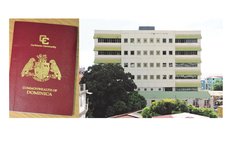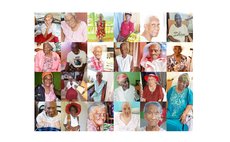Go ahead, Dominicans. Make diabetes a family affair

One of the major challenges to the attainment of Dominica's goal of being the world's first climate change resilient country is the impending tsunami of non-communicable diseases that Dr. Carrisa Etienne warned the nation about a few years ago. Few people talk about that when they discuss NCDs and the near impossible task of controlling the NCD tsunami within five years, the period that Government says it will take to achieve that goal of being a climate change resilient nation.
As we wrote last year, Hurricane Maria, the category five storm that blew away and washed down Dominica on 17 September 2017, will have many after effects. Firstly, we were made aware, again, that the concept of food security that we have been brandishing about for decades was just another pipe dream. Just days after Maria unleashed its fury on our agricultural sector many of us were afraid of starvation.
But most importantly, Maria affected our eating patterns. Thanks to our friends and neighbours we had lots of tinned foods to fill our bellies but fruits and vegetables were scarce and extremely expensive. Diabetes, the major non-communicable disease in Dominica, may take its toll after Maria.
On World Diabetes Day, observed here on November 14th, the International Diabetes Association (IDA) made us aware of some alarming statistics. For example, we now know that diabetes is a silent killer that sends one person to his grave every 10 seconds. Today, more than 366 million people worldwide are living with diabetes and by 2030 this figure is expected to increase to over 552 million. Each year another seven million people develop diabetes. This growing epidemic is threatening to overwhelm global healthcare services, wipe out some indigenous populations and undermine economies worldwide, especially in developing countries. Each year more than 4.6 million people die from diabetes-related causes, more lives annually than from HIV/AIDS. The world-wide cost of health care due to diabetes in 2011 was US$465 billion. These are rather frightening figures. But there's more.
Type 1 diabetes, which predominately affects youth, is rising alarmingly worldwide, at a rate of 3% per year. Some 70,000 children are expected to develop Type 1 diabetes annually. On the other hand, Type 2 diabetes is responsible for 90 -95% of diabetes cases and is increasing at frightening rates globally as a result of urbanization, high rates of obesity, sedentary lifestyles and stress. So the statement that we used in 2011(when we wrote an editorial about diabetes): "I'm diabetic, are you", borrowed from an old Discover Dominica campaign, in some respects is absolutely relevant to the diabetes epidemic in 2018.
The facts show that in many countries in Asia, the Middle East, Oceania and the Caribbean, diabetes affects up to 20% of the adult population. These countries bear the brunt of the major increase in diabetes prevalence but also the burden of the costs. Indigenous populations face genocide because of their high genetic predisposition for Type 2 diabetes. The IDA estimates that 11.5 per cent of Dominica's population have been affected by diabetes, a chronic disease marked by elevated blood glucose levels.
Though the Caribbean has generally taken the diabetes epidemic quite lightly, health officials have persistently warned of the problem. And the cost of managing diabetes could be too much for a country that's waking up from the most severe effects of climate change. An analysis by the World Health Organisation (WHO) in 2003 indicated that countries of Latin America and the Caribbean spent US$3 billion (US$ 353 per person) per year on the management and control of diabetes. Direct costs were higher: US$10.7 billion or $701 per person.
Obesity, the major cause of diabetes, is the challenge all Caribbean countries have to overcome. There's no doubt that the problem of obesity in the Caribbean poses "a major threat" to the economic survival of the region and that efforts at curtailing this problem must be pursued "with vigor".
Dominica has its fair share of cases of diabetes in addition to high risk factors which are known to contribute to the disease. Research has shown that approximately 12% of females are diabetic and surprisingly the figure in males is twice as high. The first four causes of death here are consistently hypertensive heart disease, diabetes, coronary heart disease and strokes. About 30% of males are overweight or obese and females show twice that figure. About two out of every three Dominican women are overweight or obese. About 16% of males had low levels of physical activity and the figure for females was twice as high".
As a result of the scale of the problem, no single government or region is equipped to tackle it and countries with the least resources are expected to bear the brunt of the increase in diabetes cases and the burden of the associated costs. The humanitarian, social and economic costs are immense. But there is hope in this environment of gloom.
We have the knowledge to tackle the diabetes epidemic and reduce the suffering and the pre-mature deaths. We also have cost-effective strategies to prevent or delay the onset of diabetes complications. Now, as the theme for World Diabetes Day 2018 suggests ("The Family and Diabetes") all members of the family need to come together to tackle diabetes. Come on Dominicans, let's make the fight against diabetes a family battle.




